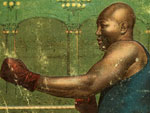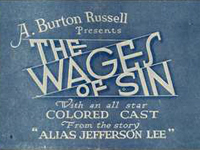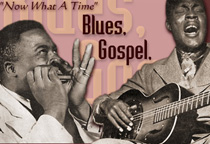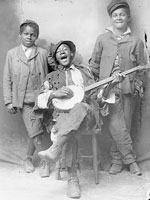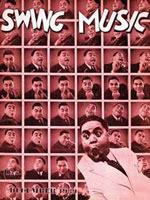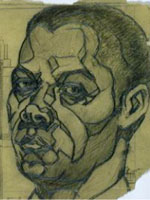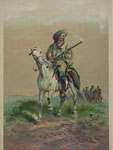To teach history without primary sources is analogous to building a house without walls. Without the structure of authentic historical references, student understanding will collapse if it is confined to the subjectivity of teachers, texts, and the modern world around them. Albeit, most teachers and texts attempt to provide a balanced delivery of content, but nothing beats the analytical dissection of an actual primary document and the historical truth that can be garnered from it. As an added bonus, primary-source activities can augment the redevelopment of history curricula that are finally beginning to recognize the significance of these critical resources.
I think [my students] know what primary documents are, but I'm not sure they understand why they are important.
So who am I? Most likely, I am just like you! I have been teaching U.S. history (AP and regular) for 15 years and I have had some pretty nice successes. I've incorporated primary sources into my lectures, projects, and PowerPoints; I have asked students to periodically find their own content-related primary sources; I have used Document-Based Essay questions to help prepare kids for the AP exam; and recently, I even combined primary source research with a Wiki assignment (see my earlier blog entry). Overall, I feel like I have met or exceeded my district and state standards and my students are certainly exposed to a wide array of primary sources throughout the year. But, I still feel like there is a gap in my student's learning. I think they know what primary documents are, but I'm not sure they understand why they are important. For some, this might seem like a hair-splitting point, but for me, it is the difference between providing a busywork time-killer and demanding high-level critical analysis. It is at the core of historical thinking and a skill that I feel obligated to expose my students to before they go off to college. Luckily, I attended a seminar offered by the Teaching American History (TAH) Grant project "Ties That Bind" that provided an adaptable template for me to follow when I am attempting to evaluate and analyze primary sources with my students.
What are Go To The Source (GTTS) Activities?
Created by Professor William Virden, founder of the Colorado Institute for Historical Study and a professor at the University of Northern Colorado, and his partner Mary Borg in 2000, Go To The Source (GTTS) Activities are basically teacher-created questionnaires that are focused upon a single primary source or a small collection of primary sources. Since they are teacher generated, the documents and artifacts can be hand-selected for age-appropriateness, relevance, and wow factor. In addition, teachers can differentiate the process for all levels and abilities.
A Specific Example
In creating my "Go To The Source" activities, I started with a general topic like "The West" and worked with local college libraries and museum archives, to augment the internet resources that I found. I found that preparation was the key to getting the most from my research time. I contacted librarians and archivists ahead of time and they happily pulled resources before I arrived. They typically love their collections and are passionate about helping researchers, so utilize their expertise. Most of the information I used was from the Colorado Springs Pioneer Museum and the Pikes Peak (Carnegie) Library.
One of my favorite pieces was a Poster from the Buffalo Bill Wild West Show. Click the link and go to pages 8 and 9 to see the poster and my GTTS activity associated with it. Keep this activity open in another window for reference.
I chose the poster because I thought it addressed a number of the themes I was trying to elucidate to my students about the allure of the American West, specifically the romantic notions that were associated with it. My students seemed to agree when they took part in the GTTS activity associated with it. They really liked it and actually asked to do more of them.
Prior to the lesson, I tried to contextualize the poster, by teaching most of the traditional history associated with the West. In an attempt to dive a little deeper, I tried to help the kids understand that modern notions about the West are often glorified, embellished, and romanticized by movies, literature, and other forms of media. So much so that many of the stereotypes that we see as "western," have been transferred across the globe and have been woven into the histories of Australia, Italy, Brazil, Mexico, etc. The Buffalo Bill poster serves as a wonderful piece of evidence in this discussion.
My next step was to analyze the poster and deduce all of the components that I wanted the kids to draw from it. Once I knew what I wanted them to learn, I wrote questions to help them dissect the poster like a historian.
LOTS and HOTS Questions
In GTTS activities, these questions take two forms. The first questions establish who, what, why, when, and where. The answers to these Lower Order Thinking (LOTS) questions should be easily identifiable and relatively simplistic for students, but provide them with important information necessary to analyze and evaluate the document. (See questions 1-5 on the GTTS activity for examples of LOTS questions.)
Once the students get into the document, now it is time to help them see the real significance of it. This can be done by transitioning to Higher Order Thinking (HOTS) questions. These should challenge students to: explain, compare, contrast, predict, hypothesize, infer, value, judge, and justify. Often these questions begin with Why, How, In what ways, Imagine, Suppose, Predict, If…then, Defend, Justify, or Judge. Once students have completed these, they should have a grasp of not only the who, what, and where of the document, but of its historical relevance and significance. (See questions 6-9 on the GTTS activity for examples of HOTS questions.)
TIP: Do not neglect the LOTS questions! I have a tendency to jump right to the HOTS questions because I am much more interested in the deeper analysis of the source (especially with my AP classes); however, students often need the LOTS questions to build their deductive reasoning skills. Because we, as teachers, are more versed in looking at historical sources, we analyze the basics very quickly. Students usually don't. The LOTS questions will allow them to practice this fundamental component of historical thinking. Try to write questions that help them do this.
Once you have engaged your students with a compelling and relevant primary source, it might be fun to offer an extension exercise. These allow students to apply the information gathered from the GTTS exercise by asking them to create a tangible end product that demonstrates how effectively they conceptualized the significance of the sources they analyzed. Some potential lessons could include essays, graphs, charts, webbing, diagrams, historical fiction short stories, timelines, newspapers or magazines, predictions for the future, small group presentations or PowerPoints, maps, posters, games, dioramas, letters or telegrams, compare and contrast activities, and even the creation of document-based questions. Let your teacher magic flow through!
Lastly, I think it is important that I thank Professor Virden for his generosity and his undying passion in helping teachers realize the significance of primary sources in the classroom. His hard work, along with that of his assistant Tom Carson and all of the wonderful lecturers at the seminar, allowed me to grow as an educator and historian and for that I am sincerely grateful. I know Bill is fond of saying "nothing that can be memorized is history," and with these GTTS exercises, my students are beginning to see the truth in those words.
Please feel free to contact me with any questions, comments, or concerns about this process. I'd be happy to share my experiences with you.
Ron Gorr
Air Academy High School
Colorado Springs, Colorado
rmgorr@comcast.net
